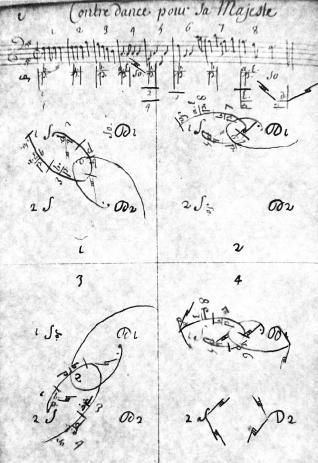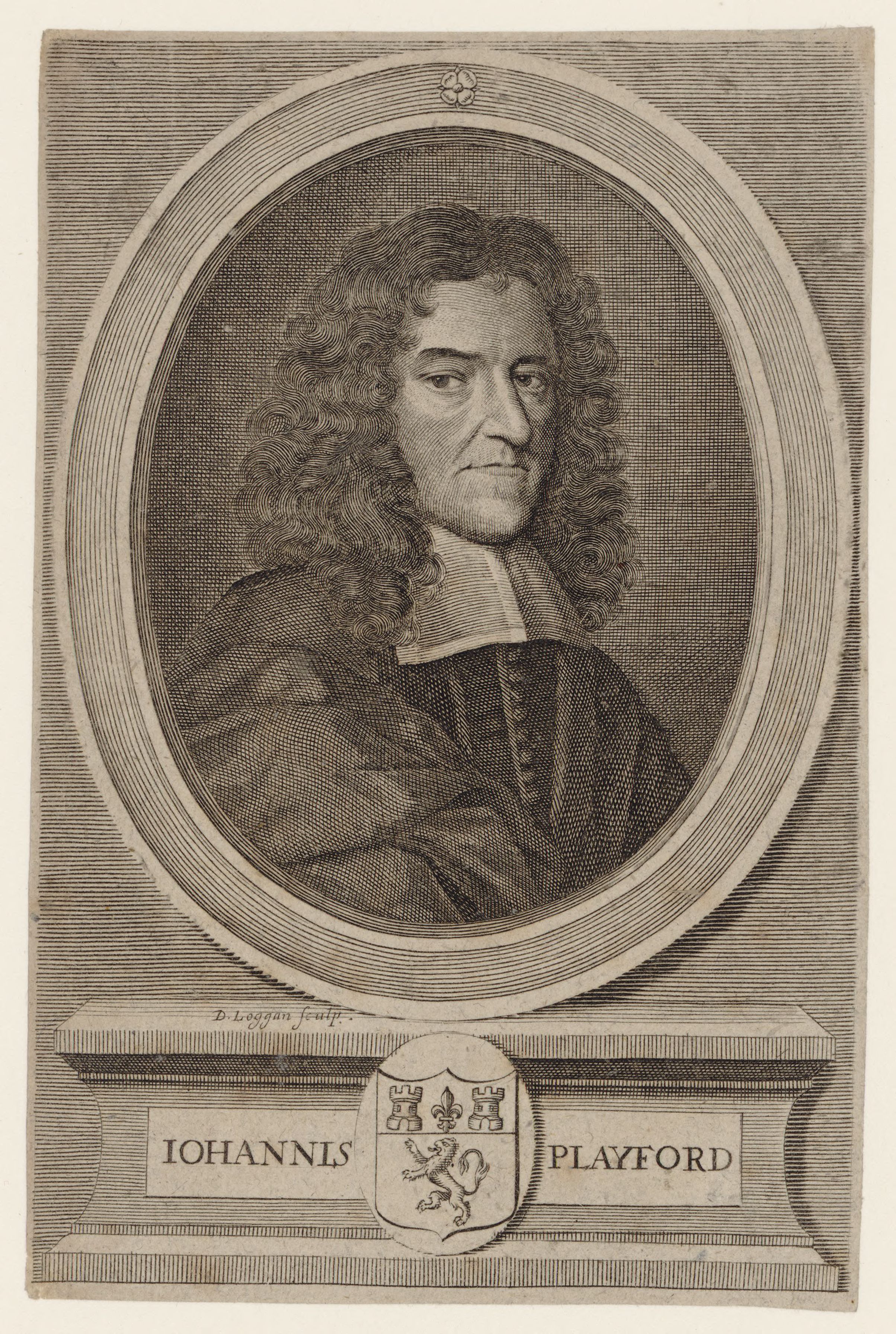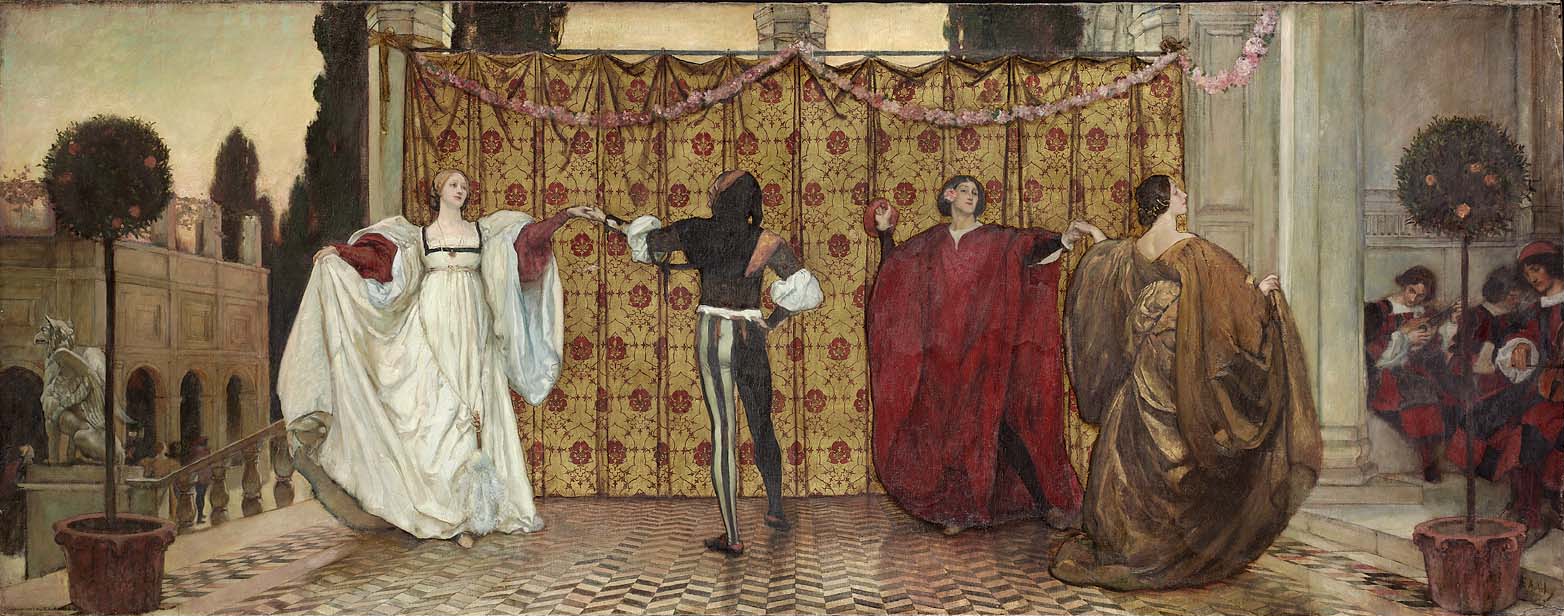|
Court Dance
Historical dance (or early dance) is a term covering a wide variety of Western European-based dance types from the past as they are danced in the present. Today historical dances are danced as performance, for pleasure at themed balls or dance clubs, as historical reenactment, or for musicological or historical research. Dances from the early 20th century can be recreated precisely, being within living memory and after the advent of film and video recording. Earlier dance types, however, must be reconstructed from less reliable evidence such as surviving notations and instruction manuals. For performance dancing, see History of dance. Categories Medieval dance Very little evidence survives about medieval dance except what can be gleaned from paintings and works of literature from this time period. Some names of the dances which we know existed during the Middle Ages include Carole, Ductia, Estampie ( Istampitta), Saltarello, and the Trotto. The farandole is also frequently p ... [...More Info...] [...Related Items...] OR: [Wikipedia] [Google] [Baidu] |
Branle
A branle (, ), also bransle, brangle, brawl, brawle, brall(e), braul(e), brando (in Italy), bran (in Spain), or brantle (in Scotland), is a type of French dance popular from the early 16th century to the present, danced by couples in either a line or a circle. The term also refers to the music and the characteristic step of the dance. History Beginnings and courtly adoption The name ''branle'' derives from the French verb ''branler'' (to shake, wave, sway, wag, wobble), referring to the side-to-side movement of a circle or chain of dancers holding hands or linking arms. Dances of this name are encountered from about 1500 and the term is used for dances still danced in France today. Before 1500, the only dance-related use of this word is the "swaying" step of the basse danse. The branle was danced by a chain of dancers, usually in couples, with linked arms or holding hands. The dance alternated a number of larger sideways steps to the left (often four) with the same number of sm ... [...More Info...] [...Related Items...] OR: [Wikipedia] [Google] [Baidu] |
English Country Dance
A country dance is any of a very large number of social dances of a type that originated in the British Isles; it is the repeated execution of a predefined sequence of figures, carefully designed to fit a fixed length of music, performed by a group of people, usually in couples, in one or more sets. The figures involve interaction with your partner and/or with other dancers, usually with a progression so that you dance with everyone in your set. It is common in modern times to have a "caller" who teaches the dance and then calls the figures as you dance. Country dances are done in many different styles. As a musical form written in or time, the contredanse was used by Beethoven and Mozart. Introduced to South America by French immigrants, Country Dance had great influence upon Latin American music as contradanza. The ''Anglais'' (from the French word meaning "English") or ''Angloise'' is another term for the English country dance. A Scottish country dance may be termed an ... [...More Info...] [...Related Items...] OR: [Wikipedia] [Google] [Baidu] |
The Dancing Master
''The Dancing Master'' (first edition: ''The English Dancing Master'') is a dancing manual containing the music and instructions for English country dances. It was first published in 1651 by John Playford. History It was published in several editions by John Playford and his successors from 1651 until . The first edition contained 105 dances with single-line melodies. The 1651 book ''The Dancing Master'' by John Playford had been designed for teaching dancing. It was originally small so that the dancing master could hide it under his cloak and consult it surreptitiously. Subsequent editions introduced new songs and dances, while dropping others, and the work eventually encompassed three volumes. Dances from ''The Dancing Master'' were re-published in arrangements by Cecil Sharp in the early 20th century. In 1957 Margaret Dean Smith completed her facsimile book ''Playford's English Dancing Master''. This work had been the first publication of English dance tunes and her publ ... [...More Info...] [...Related Items...] OR: [Wikipedia] [Google] [Baidu] |
John Playford
John Playford (1623–1686/7) was a London bookseller, publisher, minor composer, and member of the Stationers' Company, who published books on music theory, instruction books for several instruments, and psalters with tunes for singing in churches. He is perhaps best known today for his publication of '' The English Dancing Master'' in 1651. Biography Playford was born in Norwich, the younger son of John Playford. He served an apprenticeship in London with publisher John Benson from 1639/40 to 1647, after which he remained in the capital, opening a shop in the porch of Temple Church. Playford was clerk to the church, and probably resided with his wife Hannah over the shop until 1659. He was, it appears (from the title-pages of his publications) temporarily in partnership with John Benson in 1652, and with Zachariah Watkins in 1664 and 1665. Under the Commonwealth (1649–60), and for some years of Charles II's reign, Playford almost monopolised the business of musi ... [...More Info...] [...Related Items...] OR: [Wikipedia] [Google] [Baidu] |
Baroque
The Baroque (, ; ) is a style of architecture, music, dance, painting, sculpture, poetry, and other arts that flourished in Europe from the early 17th century until the 1750s. In the territories of the Spanish and Portuguese empires including the Iberian Peninsula it continued, together with new styles, until the first decade of the 19th century. It followed Renaissance art and Mannerism and preceded the Rococo (in the past often referred to as "late Baroque") and Neoclassical styles. It was encouraged by the Catholic Church as a means to counter the simplicity and austerity of Protestant architecture, art, and music, though Lutheran Baroque art developed in parts of Europe as well. The Baroque style used contrast, movement, exuberant detail, deep colour, grandeur, and surprise to achieve a sense of awe. The style began at the start of the 17th century in Rome, then spread rapidly to France, northern Italy, Spain, and Portugal, then to Austria, southern Germany, and Russia ... [...More Info...] [...Related Items...] OR: [Wikipedia] [Google] [Baidu] |
Tourdion
The ''tourdion'' (or ''tordion'') (from the French verb "tordre" / to twist) is a lively dance, similar in nature to the galliard, and popular from the mid-15th to the late-16th centuries, first in the Burgundian court and then all over the French Kingdom. The dance was accompanied frequently by the basse danse, due to their contrasting tempi, and were danced alongside the pavane and galliard, and the allemande and courante, also in pairs. In a triple meter, the tourdion's "was nearly the same as the Galliard, but the former was more rapid and smooth than the latter". Pierre Attaingnant published several tourdions in his first publication of collected dances in 1530, which contains, as the sixth and seventh items, a basse dance entitled "La Magdalena" with a following tourdion (it was only in 1949 that César Geoffray arranged this "following" tourdion as a four-voice chanson, by adding the lyrics "Quand je bois du vin clairet..."). Thoinot Arbeau Thoinot Arbeau is the ana ... [...More Info...] [...Related Items...] OR: [Wikipedia] [Google] [Baidu] |
Sarabande
The sarabande (from es, zarabanda) is a dance in triple metre, or the music written for such a dance. History The Sarabande evolved from a Spanish dance with Arab influences, danced by a lively double line of couples with castanets. A dance called ''zarabanda'' is first mentioned in 1539 in Central America in the poem ''Vida y tiempo de Maricastaña'', written in Panama by Fernando de Guzmán Mejía. In 1596, Alonso López, "el Pinciano", traces its origins even to the Dionysian cult. The dance seems to have been especially popular in the 16th and 17th centuries, initially in Spain and in the Spanish colonies. The Jesuit priest Juan de Mariana thought it indecent, describing it in his ''Tratato contra los juegos públicos'' (Treatise Against Public Amusements, 1609) as "a dance and song so loose in its words and so ugly in its motions that it is enough to excite bad emotions in even very decent people".Jane Bellingham, "Sarabande", ''The Oxford Companion to Music'', edited b ... [...More Info...] [...Related Items...] OR: [Wikipedia] [Google] [Baidu] |
Pavane
The ''pavane'' ( ; it, pavana, ''padovana''; german: Paduana) is a slow processional dance common in Europe during the 16th century (Renaissance). The pavane, the earliest-known music for which was published in Venice by Ottaviano Petrucci, in Joan Ambrosio Dalza's ''Intabolatura de lauto libro quarto'' in 1508, is a sedate and dignified couple dance, similar to the 15th-century basse danse. The music which accompanied it appears originally to have been fast or moderately fast but, like many other dances, became slower over time . Origin of term The word ''pavane'' is most probably derived from Italian 'danza''''padovana'' , , meaning "ancetypical of Padua" (similar to Bergamask, "dance from Bergamo"); ''pavan'' is an old Northern Italian form for the modern Italian adjective ''padovano'' (= from Padua). This origin is consistent with the equivalent form, ''Paduana''. An alternative explanation is that it derives from the Spanish ''pavón'' meaning ''peacock'' . Alth ... [...More Info...] [...Related Items...] OR: [Wikipedia] [Google] [Baidu] |
Lavolta
The volta (plural: voltas) (Italian: "the turn" or "turning") is an anglicised name for a dance for couples that was popular during the later Renaissance period. This dance was associated with the galliard and done to the same kind of music. Its main figure consisted of a turn and lift in a sort of closed position, which could be done either to the right or to the left. It is also called La volta, Volta, Volte. Spelling variants include la volta and levolto; its name is ''la volte'' in French and ''la volta'' in Italian. It was considered at first to be risque and controversial. Although the dance was known at the court of Elizabeth I, the popular notion (much portrayed in film and television) that Elizabeth and her favourite Lord Robert Dudley regularly performed the volta has been repudiated.Ian Pittaway Description Detailed instructions for voltas were written by Thoinot Arbeau; some brief notes appear in MS Douce 280. (about 1606) These instructions are open to s ... [...More Info...] [...Related Items...] OR: [Wikipedia] [Google] [Baidu] |
Galliard
The ''galliard'' (; french: gaillarde; it, gagliarda) was a form of Renaissance dance and music popular all over Europe in the 16th century. It is mentioned in dance manuals from England, Portugal, France, Spain, Germany, and Italy. Dance form The ''galliard'' is not an improvised dance, but rather, it consists of choreographed patterns of steps, which occupy one or more measures of music. In one measure, a galliard typically has five steps; in French such a basic step is called a ''cinq pas'' and in Italy, ''cinque passi''. This is sometimes written in English sources as ''sinkapace''. These steps are: right, left, right, left, cadence. The galliard is an athletic dance, characterised by leaps, jumps, hops and other similar figures. The main feature that defines a galliard step is a large jump, after which the dancer lands with one leg ahead of the other. This jump is called a ''cadence,'' and the final landing is called the ''posture.'' The cadence is typically preceded by ... [...More Info...] [...Related Items...] OR: [Wikipedia] [Google] [Baidu] |






